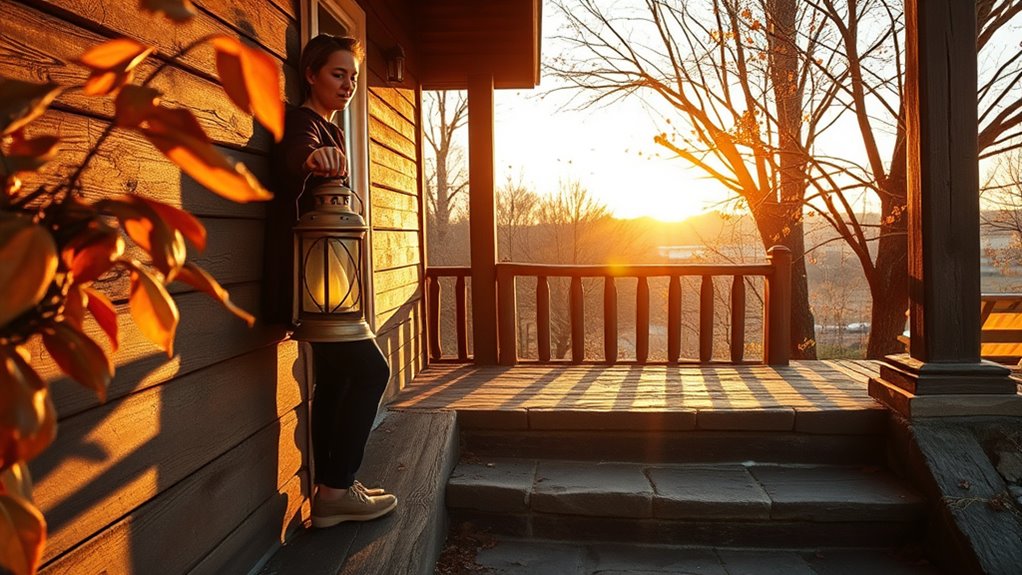As days get shorter, you can ease the shift by sticking to a consistent sleep schedule, opening curtains in the morning, and avoiding screens before bed. Spending time outdoors during midday helps maximize natural light and boost your mood. Dressing in layers and planning outdoor activities around sunlight also make a big difference. Keep these habits in mind, and you’ll find it’s easier to stay energized and balanced—there’s much more you can do to adapt smoothly during fall.
Key Takeaways
- Maintain a consistent sleep schedule and open curtains in the morning to maximize natural light intake.
- Schedule outdoor activities during midday or early afternoon to boost sunlight exposure.
- Limit blue light exposure an hour before bedtime to support melatonin production.
- Engage in relaxing routines like reading or gentle stretches to wind down and improve sleep quality.
- Use technology and planning to prioritize outdoor time during shorter daylight hours, easing seasonal transition.

Have you noticed how the days start to get shorter, leaving less sunlight to enjoy? It’s a clear sign that fall is settling in, and with it comes the challenge of adjusting to the time change. The shift can disrupt your usual routines, especially your sleep patterns and outdoor activities. But don’t worry—you can adapt smoothly by making some simple changes that help you maintain your energy and well-being.
First, consider your sleep routines. As daylight hours decrease, your body’s internal clock gets thrown off, making it harder to fall asleep or wake up feeling refreshed. To counteract this, try sticking to a consistent sleep schedule, even on weekends. Going to bed and waking up at the same time each day helps regulate your circadian rhythm, making it easier to fall asleep naturally. Limit screen time an hour before bedtime, since the blue light emitted by devices can interfere with melatonin production. Instead, wind down with relaxing activities like reading or gentle stretches to signal to your body that it’s time to rest. If you’re feeling especially sluggish in the mornings, opening your curtains as soon as you wake up allows natural light to flood in, helping reset your internal clock.
Maintain a consistent sleep schedule and limit screen time before bed to support your body’s natural rhythm.
Outdoor activities also play a crucial role in adjusting to the shorter days. As the sun sets earlier, it’s important to maximize the daylight hours you have. Plan outdoor exercise or leisurely walks during midday or early afternoon when the sun is at its peak. This not only boosts your exposure to natural light, which helps regulate your sleep-wake cycle, but also lifts your mood. Bright outdoor activities can make a big difference in combating seasonal blues and keeping your energy levels steady. If you’re pressed for time, even a quick walk around the block or some gardening can be enough to soak up the sunlight. Additionally, dressing in layers and choosing well-lit outdoor spaces can make your outings more comfortable and enjoyable. Embracing AI-powered data analytics can help you identify the best times for outdoor activities based on sunlight patterns and your personal schedule.
Adjusting to the fall time change is all about intentionality. By prioritizing consistent sleep routines and making the most of daylight hours for outdoor activities, you can ease the transition and preserve your vitality. Remember, it’s natural for your body to need some time to adapt, but with a little planning, you’ll find yourself adjusting more easily and still enjoying the crisp autumn air. The key is to stay mindful of your routines and seek out natural light whenever possible, helping you stay energized and balanced despite the shorter days.
Frequently Asked Questions
How Long Does It Typically Take to Fully Adapt?
It usually takes about a week to two weeks for your body to fully adapt to the fall time change. During this period, your circadian rhythms adjust, which can temporarily affect your sleep quality. To speed up the process, stick to a consistent sleep schedule, get plenty of natural light, and avoid screens before bed. With patience and these tips, you’ll regain better sleep and sync with the new schedule faster.
Can Supplements Help Ease the Transition?
Yes, supplements can help ease your changeover. Melatonin supplements may regulate your sleep cycle, making it easier to fall asleep earlier as days shorten. Increasing your vitamin D intake can boost your energy and mood, combating seasonal fatigue. Be sure to take melatonin about 30 minutes before bedtime and get your vitamin D from sunlight or supplements. Always consult a healthcare professional before starting new supplements to make sure they fit your needs.
Does Fall Time Change Affect Mental Health?
You might notice a subtle shift in your mood during fall, as the seasonal affective changes and sleep disruptions can influence your mental health. Shorter days reduce sunlight, potentially leading to feelings of gloom or fatigue. Staying active, getting natural light, and maintaining a consistent sleep schedule can help counteract these effects. Remember, you’re not alone—many experience this progression, and small steps can make a big difference in how you feel.
Are Children More Sensitive to Daylight Changes?
Yes, children are more sensitive to daylight changes, which can impact their sleep patterns. When daylight hours decrease, their bodies may struggle to adjust, leading to disrupted sleep and mood swings. You can help by maintaining consistent bedtimes, encouraging outdoor activities during daylight, and creating a calming bedtime routine. Recognizing their heightened daylight sensitivity allows you to support their adjustment, ensuring they stay healthy and well-rested during shorter days.
How Can I Maintain Productivity During Darker Days?
You can stay productive during darker days by establishing a consistent morning routine that includes exposure to natural light or using light therapy lamps. Prioritize sunlight in your schedule, perhaps by taking short walks outside or opening blinds early. Additionally, incorporate activities that boost your mood and energy levels. These habits help regulate your circadian rhythm, keeping you alert and focused despite the shorter days.
Conclusion
As you adapt to the shorter days, remember you’re not alone—about 20% of people experience seasonal mood changes. Embrace routines that boost your mood, like outdoor walks and regular sleep schedules. Even small adjustments can make a big difference in how you feel. With patience and some effort, you’ll find your rhythm again, making the most of each day despite the falling daylight. Stay positive—you’ve got this!









